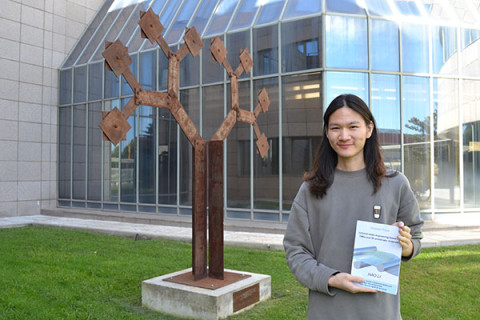Hao Li defends his PhD: "It is my huge honor to work in such a place with an excellent academic environment"

Hao Li, a PhD student at the Materials Science Institute of Madrid (ICMM-CSIC), is defending his thesis on October, 16th, at 11 AM at Facultad de Ciencias (UAM). Entitled 'Uniaxial strain engineering based on TMDs and 2D anisotropic materials' and directed by Andrés Castellanos-Gomez and Mar García Hernández, the thesis "mainly focuses on the strain engineering based on 2D anisotropic materials", explains the research.
How would you explain your research to a non-scientific audience?
My work mainly focuses on the strain engineering based on 2D anisotropic materials. Like a bamboo, it always grows along a vertical orientation and if you bend it with a force, it is always easier to get broken along the vertical direction. 2D anisotropic materials act in a similar way, their properties behave differently along different crystalline orientations. What I do is to apply strain along various crystalline orientations of 2D anisotropic materials. This could be achieved by first transferring a nanoflake on a disk-like polymer substrate and then bending it along different directions by rotating the sample. Further, we are able to observe a shift of excitons or Raman modes on these materials induced by strain. Interestingly, the shift rate presents a strong dependence on the direction which we apply strain, which is closely related to the various crystalline structures of these 2D anisotropic materials. Finally, one can tune the electrical and optoelectrical properties of these materials and apply them to devices.
What are the main applications of your research? Could you give us an example?
Strain sensor is one of the main applications of my research. In a strain sensor device, a strain gauge is a sensor whose resistance varies with applied force; It converts force, pressure, tension, weight, etc., into a change in electrical resistance which can then be measured. 2D anisotropic materials-based strain sensors endow the potential of exhibiting different resistance responses when strain is applied along different directions, which broadens the strain sensors application field.
Why did you choose ICMM for your PhD?
I was working on 2D materials when I was doing my master's study. I have read Prof. Andres Castellanos Gomez’s paper about black phosphorus which was a quite newfangled 2D material in my cognition. Then I decided to go abroad to proceed my PhD study and with serendipity, I contacted with Prof. David Perez de Lara, who was eventually not able to supervise me but recommended me to Prof. Andres Castellanos Gomez. Then I had an interview with Prof. Castellanos and joined the 2D Foundry group in ICMM. I must say that it is my huge honor to work in such a place with an excellent academic environment.
What are the lessons you have learned here? which one do you value the most?
Actually, I have learned a bunch of lessons here, from experimental skills, and team collaboration, to interpersonal communications. Well, the thing that I value most is that always keep passionate and responsible for the thing you really love, especially a thing that will company with you for a long long time.
How do you think this experience will contribute to your training and to your future?
Of course, this experience would contribute a lot to my future life, in both work and life. Firstly, all the experimental skills I have been trained in and scientific networks will still be of great help in my future career and the exploration of new possibilities. Secondly, I gave gained a lot of experience in teamwork and communications which will be beneficial in my future life; finally, this experience will always be sparkling deep inside of my heart and support me to move on!
What are your plans once you finish your PhD?
My plan is to work as a Postdoc in the Chinese Academy of Sciences, China. I will be working on the Lidar system which might be different from what I am working on now and closer to industry, while I will explore the possibilities for combination.
Why did you become a scientist? Who have been your role models?
I have always been better at Science since I was a kid. I remembered that we had Science and Nature lessons when I was in my fifth grade, which made me really curious about the gorgeous nature, the fantastic matter, and the incredible world, that would have inspired my interest in scientific research. My role model would be Marie Curie, a physicist and chemist who conducted pioneering research on radioactivity. Plus, she was the first woman to win a Nobel Prize, which would be a really difficult thing (to be recognized as a woman scientist) in that period. I really appreciate her passion for radioactivity study and her contribution to cancer therapy.
ICMM
Sor Juana Ines de la Cruz, 3
Cantoblanco, 28049
Madrid, España
Teléfono: (+34) 91 334 90 00
Email: @email
Oficina de Comunicación/Prensa: @email

Acknowledge the Severo Ochoa Centres of Excellence program through Grant CEX2024-001445-S/ financiado por MICIU/AEI / 10.13039/501100011033

Contacto | Accesibilidad | Aviso legal | Política de Cookies | Protección de datos